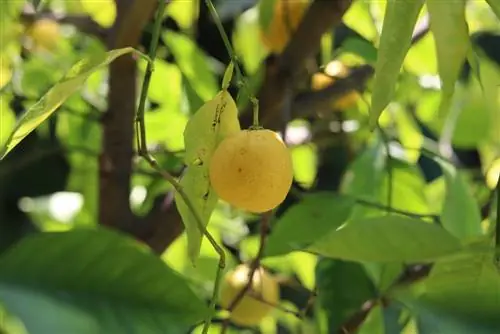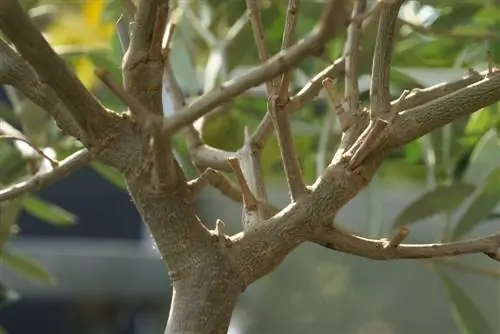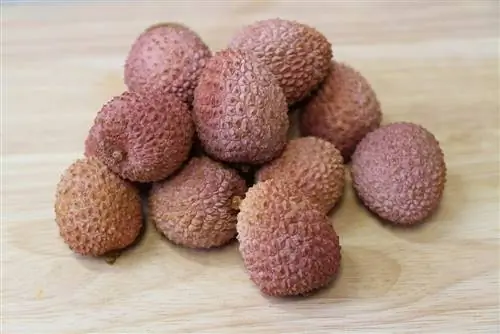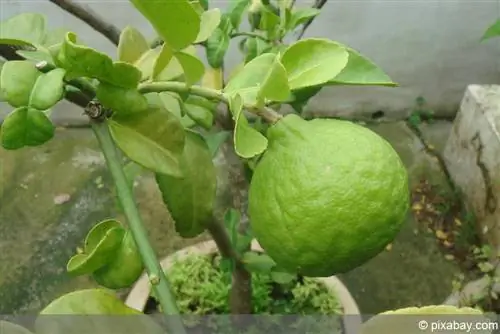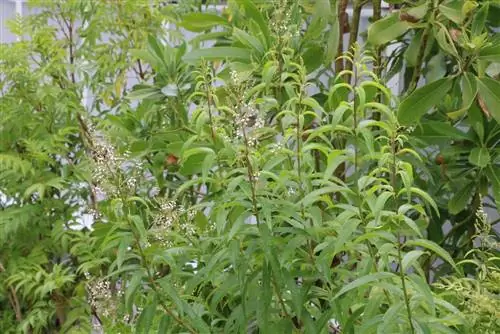- Author admin [email protected].
- Public 2023-12-17 03:39.
- Last modified 2025-06-01 06:48.
For many people, a lemon tree evokes associations with sunny countries on the Mediterranean and makes you want fresh, untreated and, above all, home-harvested fruit. If the conditions are optimal all year round, a lemon tree can grow up to 2 m high and bloom and, ideally, bear fruit even in the cold season. However, correct wintering plays a crucial role, because this is exactly where most mistakes happen, be it in the choice of winter quarters or in watering behavior.
Wintering period
Overwintering this plant is not particularly complicated, provided you keep a few things in mind. It is important to create conditions for the plants that are species-appropriate and adapted to their natural habitat, at any time of the year. This is the only way to avoid irreparable frost damage. The lemon tree comes from a very sunny and hot climate and is therefore not hardy. In this country, summers are usually short and relatively humid and winters are cold and comparatively long. This means they can easily be left outdoors throughout the summer. However, when the growing season is coming to an end, it is time to prepare them for wintering.
- Gradually reduce the amount of watering at the end of the growing season
- Stop fertilizing from September
- The right time for wintering depends on the prevailing weather conditions
- They vary from region to region
- Even minimal temperatures below zero can result in massive frost damage
- A distinction is made between mild, mild to cold and cold areas
- Mild areas affect the west and southwest of Germany
- Mild to cold regions in the north
- Cold locations are in the east, southeast and the highlands
- Put away lemon trees in mild areas from around mid-November
- In mild to cold regions, indoors from the beginning of November
- Wintering in cold areas begins from mid/late October
In spring, winterization measures must be taken. First, plants in mild regions can go outside from around the beginning of April. The next ones will follow from around mid-April and in cold locations you should wait until after the Ice Saints. Ultimately, the prevailing weather conditions are always decisive.
Tip:
If you plant the lemon tree in a transportable pot, it makes it easier to transport it from the garden to the winter quarters and vice versa.
Location in winter
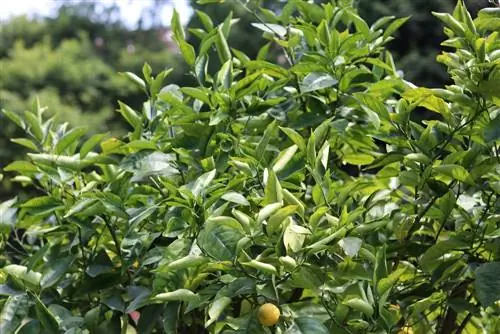
Before the lemon tree can be overwintered, it should be checked for possible pest infestation and, if present, removed first. Classic winter quarters include stairwells, bright basement rooms, frost-free greenhouses and unheated winter gardens. Frost-free outbuildings with sufficient daylight are also suitable. Heated living rooms or offices, on the other hand, are completely unsuitable. The balcony is also not suitable for overwintering; the bale would freeze in a relatively short time because the bucket walls are not insulated and do not offer any protection against frost. In addition, the respective location should be bright and draft-free.
Care in winter quarters
Unlike many native plants, this plant requires year-round care. To ensure that it feels comfortable in our latitudes, does not suffer frost damage and can produce many fragrant flowers and, ideally, fruits, there are a few basic factors that you should consider. Once parts of the plant are frozen, they usually cannot be saved. Light and temperature conditions as well as correct watering behavior play a crucial role in winter care.
Temperature and light
- Temperatures in the winter quarters during the day between 5 and 15 degrees
- At night between 9 and 12 degrees
- Sharp temperature fluctuations should be avoided
- Protect roots from rising ground cold in cold rooms
- To do this, place it on a Styrofoam plate or coconut mat
- If necessary, wrap the bucket additionally with jute or fleece
- Provide sufficient light even in cool winter conditions
- This is the only way she can maintain her vital functions
If the lemon drops its leaves or forms so-called horny shoots, this can be an indication of a lack of light. Plant lamps can also be used for higher light output. At a room temperature of up to 15 degrees, the plant needs around 6 - 8 hours of light.
Humidity
The humidity also has an influence on the development of the plants. Here too, the right balance must be found. This requires sensitivity. While too low air humidity, as is often the case in living spaces, promotes infestation with pests such as scale insects or spider mites, high air humidity has both advantages and disadvantages.
When the humidity is high, pests have difficulty multiplying and plants can absorb the missing moisture in the root area through their leaves. A disadvantage, for example, is the increased susceptibility to gray mold rot (Botrytis), which mainly occurs on young shoots, fruits and possible wounds. If infected parts of the plant are not removed immediately, this fungus will continue to spread and can lead to the death of the plant.
Tip:
The warmer the winter quarters, the more often the lemon tree can be sprayed. In rather cold rooms, spraying with lukewarm, lime-free water is only recommended occasionally.
Pouring

When watering, you should know that lemon trees are very sensitive to hard water. Therefore, if possible, you should only use lime-free, natural rainwater for watering and spraying the plants. If only tap water is available, it should be stale for at least a week. Of course, the water at the bottom of the watering can must not be poured out as all the lime has settled here.
Especially when overwintering, you should water as needed or only enough so that the substrate does not dry out completely and is not permanently wet. You shouldn't plan fixed watering days, but check the soil moisture every few days. The cooler the room, the less watering needs to be done. It is enough to water every 4 - 6 weeks at temperatures of 5 - 10 degrees.
Fertilize
If the wintering takes place in a cool area with temperatures around 10 degrees, fertilizer can be dispensed with completely. At these temperatures, the roots largely stop all activity, so they neither need nor absorb nutrients.
Cutting
The lemon tree should be trimmed in autumn before wintering. After such a cut, there may be some loss of leaves but also loss of fruit. But the remaining ones will be even larger. For older specimens that have not been trimmed for a long time and are already balding from below, a corresponding rejuvenation cut is recommended immediately after the winter break.
Topiary
- When pruning, remove interfering, crossing and inwardly growing branches
- Also cut out diseased and dead wood as well as branches that are too close together
- No branch stubs left behind
- Always cut close to the trunk
- Remaining stumps could promote Botrytis infection
- In addition, shorten all shoots protruding from the crown by half
- This also applies to new shoots that are longer than 40 cm
- These pruning measures result in better branching
Rejuvenation cut
A rejuvenation cut is intended to give older, bare plants a proper shape again and support them in he althy growth. This cut is usually a little stronger and should therefore always be done in spring, after wintering. Afterwards, the lemon tree usually recovers very quickly and sprouts again more vigorously. In order to get a he althy and well-branched crown again, it must be shortened all around. You practically build a new branch structure and cut the entire crown back to 5 - 15 cm long stumps, even if it hurts.
While stumps are not desired when cutting topiary, they are necessary here because the lemon tree will sprout again from the sleeping buds of these stumps after about 2 - 3 weeks. And the more intensive the cut, the stronger the new growth. In order to build up a nice, compact crown shape again, all new, still herbaceous shoots are shortened to 30 to 40 cm. This stimulates better branching and prevents further balding.
Repot before clearing out

Basically, it is advisable to repot a lemon tree in fresh soil about every two years, because its roots spread quite quickly. Up to the age of 4-5 years, annual repotting is advisable. This has the advantage that the substrate does not harden, which in turn protects against waterlogging and suffocation of the roots. But even if it grows and thrives well, it needs fresh soil from time to time because it supplies the plant with important nutrients. The best time to do this is at the end of winter dormancy, when the roots start to grow again.
- The new pot is about 4 cm larger in diameter than the old one
- Fill the bottom third of the pot with drainage material
- E.g. pottery shards or coarse gravel
- On top of this a 2-3 cm thick layer of loose, well-drained substrate
- This is what a special soil for citrus plants can do
- Or a mixture of approx. 85% commercial potting soil and approx. 15% fine sand
- If necessary, incorporate a handful of horn shavings
- Then take the tree out of the old pot
- Carefully remove loose soil from the root ball
- At the same time check the root area for pest infestation
- Place the plant in the new pot at the same height
- Knock the wall of the pot several times to avoid cavities in the root area
- Then press the soil with your hands and water thoroughly
Tip:
Repotting before hibernation is not advisable, because at this time the roots almost completely stop their activity and the nutrients in the soil cannot be used by the plant; they would gradually be washed out when watering.
Moving to the garden
Before the lemon tree can finally go outside again, it should slowly get used to the new environmental conditions. In order not to unnecessarily extend the time without vegetation, and depending on the temperatures prevailing in the region in question, these plants can sometimes be placed outside for a few hours on warm, sunny days in March. However, a place with direct sunlight should be avoided, otherwise there is a risk of burns.
In the late afternoon, when it gets cooler again, they have to go back into the house. Under no circumstances should they get frost. Temperatures should no longer fall below 5 degrees both during the day and at night. The warmer it gets, the longer the plants can stay outside until they can finally stay outside completely after the Ice Saints, i.e. after May 15th. A spot in front of a south-facing wall is particularly good, as it stores the heat from the sun during the day, which then benefits the plants at night, at least initially.
Care errors during wintering
The most common care mistakes during overwintering concern watering behavior. Usually too much is watered. If the plant is still in a cold room, the leaves can quickly turn yellow and fall off. Watering too much once will damage this plant much more than watering too little twice. In addition to the amount of water, the quality of the water also plays an important role. Lemon trees prefer more acidic soil without lime. Since drinking water in Germany is very calcareous, watering should only be done with rainwater.
When using tap water, lime accumulates in the soil and leads to chlorosis (deficiency symptoms). The plant can no longer adequately absorb important trace elements such as manganese, iron or zinc because they are present in the soil but no longer in a form available to plants. In addition, sufficient ventilation in the winter quarters must be ensured to avoid gray mold infestation. However, drafts should be avoided. Since this heat-requiring plant is sensitive to cold feet, it makes sense to always place the pot on an insulating surface.
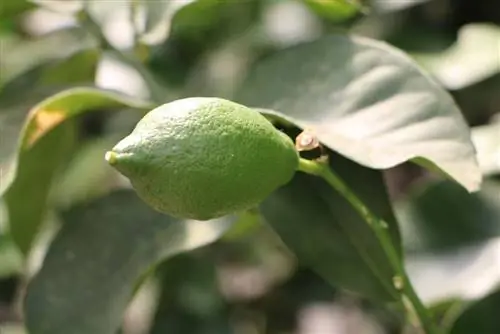
A common problem is falling leaves. Stressful situations such as frequent changes of location can be a cause for this. There is also a risk of leaf loss in locations that are too dark and too wet. In this case, you should quickly provide more light, for example by moving the plant closer to a window or, if that is not possible, using plant lamps. You only water again when the substrate has dried down to the lowest layers or you plant in drier soil.
Pests
If the lemon tree is kept cool over the winter, it is usually well protected from pest infestation. However, the warmer the winter quarters, the more vulnerable the plants are and the faster pests can spread. Plants that are already weakened due to unfavorable wintering conditions are particularly affected.
Spider mites
The eggs and fine webs of the spider mites settle primarily on the undersides of the leaves. Infestation occurs particularly in warm and dry indoor air. An initial infestation can often be eliminated by repeatedly spraying the plant vigorously. Smaller plants can also be dipped upside down in soapy water, but the substrate must be covered beforehand so that the lye does not get onto the soil. If the infestation is advanced, only appropriate insecticides from specialist retailers can usually help. It is important to make sure that the insecticide in question is also suitable for use indoors.
mealybugs and mealybugs
Mealybugs and mealybugs are covered with a white, woolly wax layer and a kind of hair. The leaves of affected plants turn yellowish, curl up, and eventually fall off. After the plant has been isolated, you can spray or brush it with a solution of 1 liter of water and 15 ml each of spirit and curd soap or paraffin oil. The treatment should be repeated at intervals of 2-3 days until the infestation has been completely eliminated.
Scale insects
Scale insects also usually appear under unfavorable housing conditions. They can be recognized by small brownish shields on leaves, petioles and twigs, as well as by sticky leaves, which are honeydew, the excretions of these pests. If the infestation is light, the animals can be wiped off with a cotton swab soaked in alcohol. If it is already advanced, they can be treated with oil-containing preparations.
Southern flair in your home garden
Many people associate a lemon tree with sun, the Mediterranean and Mediterranean joie de vivre. It is also becoming increasingly popular as a container plant in this country. However, it is sensitive to frost. If you forget it outside, it quickly freezes and can no longer be saved. If you take the conditions in your natural homeland into account when keeping and caring for these plants and implement them as best as possible, cultivating a lemon tree is not as complicated as you think.

